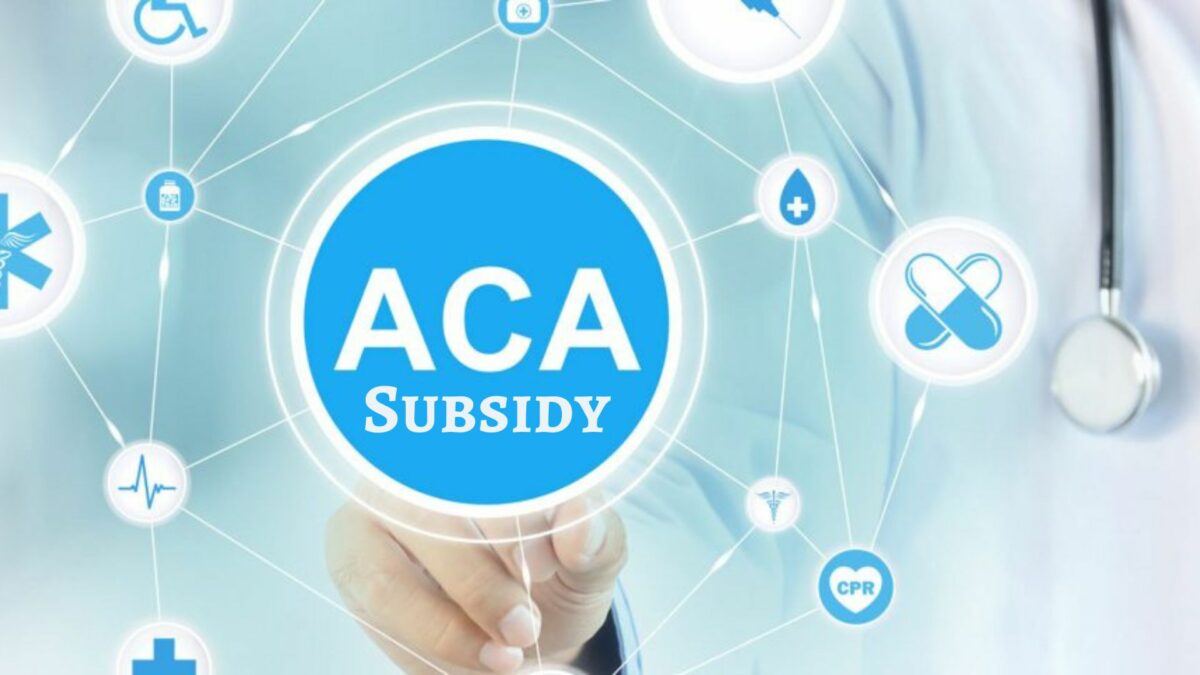Creativity is great-but not in accounting.
–Charles Scott
2021 will be the first year that we are using the healthcare marketplace provided by healthcare.gov through the Affordable Care Act (ACA). Previously, we’d used my board work through the private equity fund I co-founded to pay for our healthcare, but given that I am dialing back my board work and I wanted to get the tax benefits, we decided to do it ourselves.
The first go-through in the application, I unknowingly entered an modified adjusted gross income number too low to qualify for anything, which was indicated by my eligibility letter, because, hey, isn’t paying $0 in income taxes the goal?
Your yearly household income (REDACTED) is too low for advance payments of the premium tax credit. Generally, households whose income for the year is between 100% and 400% of the federal poverty level for their family size may be eligible.
I wasn’t actually paying attention to that letter. I just paid our first month’s premium and went about my business, figuring that it would all come out in the wash when doing 2021 taxes.
Then, I read an article by my friends at All Options Considered, which indicated that they were looking into whether or not to take a subsidy advance on their ACA enrollment in 2021.
“A subsidy advance?” I thought to myself. “Is such a thing possible?”
Indeed, it is possible. The ACA has something called a Advanced Premium Tax Credit (APTC) (because the government can’t create something with two words or more without creating an acronym for it), which means that you can apply your ACA tax credit in advance.
As an early retiree, cash flow is king. Why pay for something now and get reimbursed later when you can get the reimbursement up front?
So, I checked out the 2021 federal poverty levels and discovered that we, as a couple filing married filing jointly, needed to have at least $17,240 in modified adjusted gross income (MAGI…there goes the federal acronym machine again) to even qualify for the ACA’s credits and to be able to claim the APTC.
Back to healthcare.gov I went. I adjusted our income numbers to reflect the target, and, suddenly, our eligibility letter changed.
- Eligible for advance payments of the premium tax credit to help pay for a Marketplace plan. You can use up to this much of the tax credit:
- $977.00 each month, which is $11,724.00 for the year, for your tax household.
- This is based on the yearly household income of $17,250.04—the amount that you put on your application, or that came from other recent information sources.
This is the income tax version of p-hacking – picking numbers that get us the results we want.
If you’re concerned about doing your taxes correctly, I’ve used
TurboTax Online for several years, and, despite the complicated status of our taxes, have had no problems filing my taxes, saving us almost $1,000 compared to what we were paying our accountant when he prepared our taxes.
FIRE, Rental Properties, the ACA, and You

However, as we’ve discussed previously, we REFIREd, meaning that we are using rental properties to generate most of the income we need in retirement.
While I am not going to share our specifics, I can create a hypothetical scenario using some generalizations from my friends Josh and Brandon at BiggerPockets to illustrate the potential issue that you face if you’ve REFIREd and want to qualify for the ACA premium subsidies.
Let’s say that you’re a typical family of two who have average spending.
The average annual household budget is $60,060. If you use the BiggerPockets 50% rule, this means that you would need $120,120 in annual rental income, or $10,010 in monthly income.
How much real estate would you need to purchase in order to get that $10,010 in monthly income?
If you’re a real real estate whiz (no pun intended), then you purchase using the BiggerPockets 2% rule, meaning that you should generate at least 2% of your all-in basis costs of buying a rental property in monthly rental income.
We’re not to the Level 50 Real Estate Wizard achievement badge, so our historical rate is about 1.44%.
Therefore, to achieve that $10,010 in monthly income, you’d need to buy $692,996.52 in real estate. I assume you’ve bought these properties in cash because there is no such thing as “good debt” in our retirement plan.
When you make a purchase, though, that purchase is allocated between land and the improvements (e.g. the house that sits on the land). According to the IRS, the improvements have an expected lifespan of 27.5 years, meaning that, in addition to the other expenses associated with your rental property, such as property management and insurance, you also deduct 1/27.5 times the basis on your buildings on your tax returns.
For us, our basis, historically, has been 72.9% improvements and 27.1% land.
Therefore, on any given year, for the first 27.5 years of ownership of rental properties, this hypothetical average American couple will take $18,372.01 in depreciation.
A VERY simplified tax calculation (I’m a CFP, not a CPA) would get you this result:
|
Net income (using 50% rule) |
$60,060.00 |
|
Depreciation |
$18,372.01 |
|
Standard deduction (2021, MFJ) |
$25,100.00 |
|
AGI |
$16,587.99 |
|
100% FPL |
$17,240.00 |
|
Shortfall |
$(652.01) |
You might think to yourself that the tax burden there isn’t bad: $1,658.80, based on a 10% tax rate.
However, if this were the case, you wouldn’t qualify for the ACA credits, because your MAGI would be below the 100% Federal Poverty Level (FPL…yay government acronyms).
So, by not paying an extra $65.20 in tax by having your AGI at the 100% FPL, you’re foregoing $12,261 per year in subsidies for your health insurance if you want to use the ACA exchange.
That’s a potential $12,195.80 tradeoff not in your favor.
But how do you get that extra $652.01 in income to get the $12,261 in credits?
A Couple of Ideas to p-hack Your Taxes

For us, there are a couple of ways to p-hack our way to tax subsidy happiness.
- Roth IRA Conversion. According to the IRS,
A conversion to a Roth IRA results in taxation of any untaxed amounts in the traditional IRA.
If you contributed to a traditional IRA back in the days when you had a jobby job, then you got a tax deduction that year, reducing your AGI dollar for dollar for the amount that you contributed to the IRA. Now, by doing a conversion to a Roth IRA (or 401k), you’re going to claim the amount of the conversion as income and pay the tax in the year that you make the conversion, and later, when you reach the penalty free withdrawal age, you will not be taxed on that money. In this hypothetical scenario, a $652.01 Roth IRA (or 401k) conversion does the trick, assuming you have a traditional IRA or 401k as the basis for this conversion. - Expense Shifting. If you’re like us, you usually get a statement from your property manager in the first week or two of the month. So, by the time mid-December rolls around, we should have a really good idea of what our AGI would be. Our biggest line item in expenses in any given year is property taxes (yay Texas!). This is the price we pay for having no state income taxes. Those taxes are due in January, but, being the eager beavers we are, we pay those taxes in December. All we’d have to do in this scenario is wait to pay $652.01 in property taxes until January of next year. Yes, this kicks the can down the road by a year, but given the size of our cumulative property tax bill, we should be able to reach Medicare before the can is too big.
- Harvest Capital Gains. As I referenced earlier, we’ve done pretty well with our home run swing from the pandemic. We could just sell $652.01 worth of gains, and immediately rebuy the same securities ($0 trading costs, FTW), since the IRS is happy to take your tax money. This requires you to have investments that a) have gains, and b) are in taxable accounts. The bonus to this is that, since, in this scenario your AGI will be below the $78,750 threshold for capital gains taxes to be at 0%, you won’t be taxed on those capital gains!
As we’ve seen here, the ACA subsidy cliff can be very expensive.
If you’ve used rental properties to REFIRE, or you’re trying to be a $0 income tax targeter, you may not think much about these cliffs, but they can be VERY expensive. I’d rather pay $1,724 in taxes to get $12,261 in ACA subsidies.
It’s very important that you’re watching your P&L like a hawk in the final couple of weeks of December so that you know what your MAGI is going to be and you can adjust your income accordingly to make sure that you reach the 100% FPL or don’t exceed the 400% FPL.
Have any of you p-hacked your income to qualify for the ACA subsidies? Let’s talk about it in the comments below!
Author Profile
- John Davis is a nationally recognized expert on credit reporting, credit scoring, and identity theft. He has written four books about his expertise in the field and has been featured extensively in numerous media outlets such as The Wall Street Journal, The Washington Post, CNN, CBS News, CNBC, Fox Business, and many more. With over 20 years of experience helping consumers understand their credit and identity protection rights, John is passionate about empowering people to take control of their finances. He works with financial institutions to develop consumer-friendly policies that promote financial literacy and responsible borrowing habits.
Latest entries
 Low Income GrantsSeptember 25, 2023How to Get a Free Government Phone: A Step-by-Step Guide
Low Income GrantsSeptember 25, 2023How to Get a Free Government Phone: A Step-by-Step Guide Low Income GrantsSeptember 25, 2023Dental Charities That Help With Dental Costs
Low Income GrantsSeptember 25, 2023Dental Charities That Help With Dental Costs Low Income GrantsSeptember 25, 2023Low-Cost Hearing Aids for Seniors: A Comprehensive Guide
Low Income GrantsSeptember 25, 2023Low-Cost Hearing Aids for Seniors: A Comprehensive Guide Low Income GrantsSeptember 25, 2023Second Chance Apartments that Accept Evictions: A Comprehensive Guide
Low Income GrantsSeptember 25, 2023Second Chance Apartments that Accept Evictions: A Comprehensive Guide

